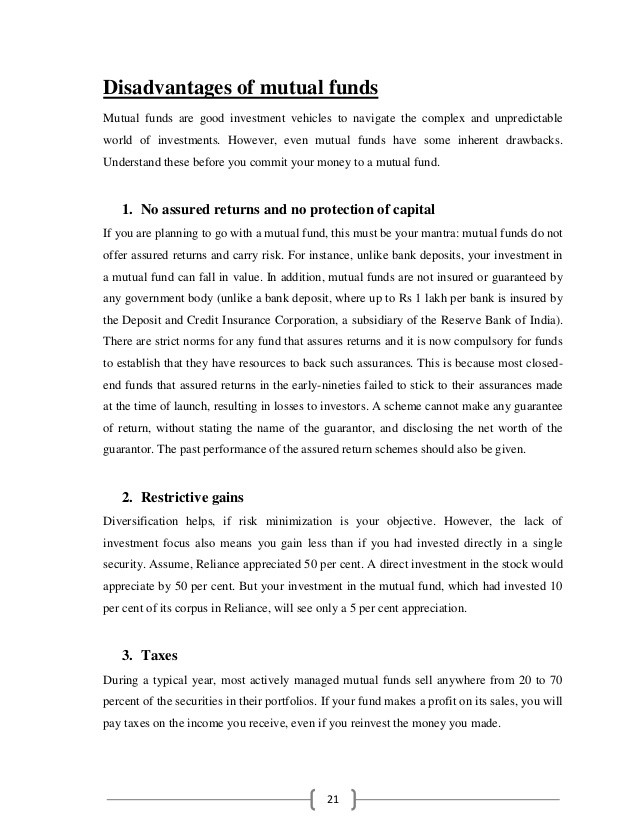Mutual Understanding A Primer on Mutual Fund Fees Investing Daily
Post on: 28 Март, 2015 No Comment

By Peter Staas on December 4, 2009
Like any other business, running a mutual fund entails costs, most of which are lopped off the top of shareholders initial investment or extracted from the funds overall returns.
Over time, seemingly negligible differences in fees and expenses can substantially reduce an investors earnings. For example, if you sink $10,000 in a fund with a 10 percent annual return and yearly expenses of 1.5 percent, after 20 years the value of your investment would have grown to just under $50,000not too shabby. Of course, if you had put this money into a fund with annual expenses of 0.5 percent, your return would be more than $60,000.
Remember that although the markets fortunes will fluctuate with time, costs remain relatively constant and are one factor over which investors have a degree of control. Understanding how fees and expenses will affect your returns, as well as who pockets these charges, should be a major concern when evaluating different mutual funds.
Mutual fund fees differ widely but generally devolve into one of two categories: one-time fees or ongoing annual expenses. Return figures reported in mutual funds annual reports and on financial Web sites typically include deductions for ongoing expenses but omit any one-time fees.
One-Time Fees
Not all fund companies saddle shareholders with one-time fees, but these charges typically occur when you buy into a fund (referred to as a front-end sales load) or when you redeem your shares (a back-end sales load).
In both instances, these payments generally compensate outside brokers who dispense investment advice and direct clients to purchase a particular fund, though some funds that dont rely on a broker network for distribution still impose sales loads.
The Financial Industry Regulatory Authority (FINRA), a non-governmental entity that oversees securities firms doing business in the US, has established rules capping front-end charges at 8.5 percent. In practice, these fees are generally 6 percent or less.
Whereas front-end sales commissions are by nature a fixed cost, some funds incrementally discount their back-end loadswhich often start at about 5 to 6 percentfor each year that investors own the funds shares. The rate at which the fee declines is disclosed in the prospectus. Such charges are referred to as contingent deferred sales loads.
Recognizing that each investor has unique goals and objectives, many fund companies offer different share classes that encompass the range of different pricing arrangements.
Investors that buy into a share class with a front-end load should remember that these upfront fees will reduce the size of their initial investment; by the same token, individuals with a longer investment horizon may benefit from a fund with a contingent deferred sales load.
Redemption fees are another one-time charge of which mutual fund investors should be aware. These fees are usually paid directly to the fundnot a broker or financial advisorwhen a shareholder redeems his or her position before a preset period of time. In this way, redemption fees protect shareholders and fund managers from difficulties that can ensue from short-term traders seeking to capitalize on the latest trend.
Shareholders of some funds may also incur a periodic account management fee if their investment is below a certain threshold amount. Exchange fees crop up when a shareholder transfers his or her investment to another fund within the same family.
Ongoing Expenses
All mutual fund investors face annual charges and deductions for various ongoing expenses, the majority of which are tabulated in a funds expense ratio, a figure that expresses these charges as a percentage of overall assets. That is, if a fund manages assets totaling $400 million and charges $2 million, it would report an expense ratio of 0.5 percent.
There are several elements to the expense ratio. Management fees are paid out of the funds assets to compensate the financial professionals who construct and maintain the funds investment portfolio. This category also includes any administrative fees, which pay for mailing prospectuses, annual reports and account statements to shareholders.
So-called 12b-1 charges constitute another major component of the expense ratio and are paid out of the funds assets. Charges that fall under this heading generally relate to marketing and distribution expenses, as outlined by the US Securities and Exchange Commission.
In some ways, marketing and distribution fees benefit investors: Advertising the fund should increase its assets, which in turn provides better economies of scale and lowers operating expenses.
At the same time, however, 12b-1 fees oftentimes further enrich brokers that sell the fund to clients, raising questions about the extent to which personal gains trump sound financial advice. Prospective investors can determine exactly how much a fund spent on broker compensation by consulting its statement of additional information.
A fund companys 12b-1 plan may also include fees related to shareholder servicesfor example, to hire staff that respond to investor inquiries and provide shareholders with information about their investment.
The costs a fund incurs when it buys and sells securities are another ongoing expense. Brokerage costs arent included in the expense ratio but, instead, are listed separately in a funds annual report or statement of additional information.
Peter Staas is deputy managing editor of Personal Finance.














